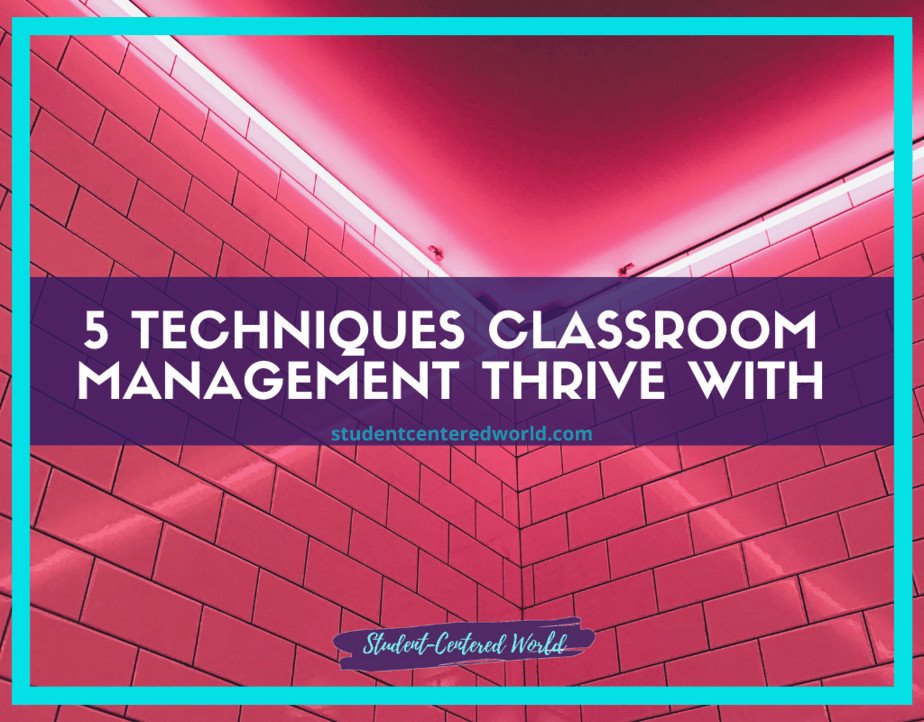Your Amazing Classroom Management Style in the 21st-Century Classroom
Every teacher has their own unique classroom management style, but that doesn’t mean that there isn’t always room for improvement as new data arises or new, catchy ideas take hold of the generation in our classroom.
The modern classroom has so many elements to it that were simply non-existent just a few short years ago. Expecting the same classroom management techniques to work in the 21st-century classroom is asking for failure.
Classroom management is not just about making sure that students are paying attention, it’s also about being involved with them as learners and individuals.
What works in your classroom may not work in mine, but know that developing a positive relationship with my students is the cornerstone of any good management system. Just like learning is built through relationships (with teachers and peers), so must discipline be an extension of these relationships.
But what does this look like in our classroom? When developing your own classroom management style, there are a few things to keep in mind.
10 Points to Remember for Classroom Management
1. The Learning Environment You Create Influences How Students Learn
Some educators might think that the only thing they’ve got to do is teach content, and whether or not students learn it isn’t their responsibility. But there’s a whole other side to student success: the environment in which you conduct your lessons and assess your students affects how much students learn.
2. Classroom Management is an Investment, Not An Expense
There’s a reason that companies invest more money into making and selling their product than they actually bring back in: it’s called profit margin. The same principles apply to your classroom management style: you can’t expect to teach for free; there has to be some room in the budget for preparing your lessons, having materials on hand, and making sure you stay organized.
3. Classroom Management is About Relationships
It’s not about how many rules you have, or how much control you exert over your students – it’s about building relationships with them that lead to respect and responsibility. If there isn’t a bond between you and your students that goes deeper than just being their teacher, then there’s not much hope of building that classroom management system that will have them voluntarily putting away the pencils when it’s time to line up.
4. Classroom Management is About Respect
If you’re willing to do something for someone, then they generally feel respected by you. You need to be willing to work for your students, even though they aren’t doing the same – it’s only fair! Students are less likely to respect someone who doesn’t take initiative with their work or is always asking them to do something new.
5. Classroom Management is About Preparation
It’s up to you to teach your students the skills they’re going to need in order to succeed: listening, following instructions, and staying organized. You can’t just spring a lesson on them and expect it all to work out: that’s like expecting someone who doesn’t know how to swim to jump into the deep end of a pool. You’ve got to raise the water level slowly until eventually, they’re standing on the ledge ready to jump off completely.

6. Classroom Management Style is About Balance
You can’t get caught up in all of these principles and think that you have it down pat – classroom management is about finding a balance! You won’t be able to do this perfectly, but if you try to establish a balance between these five elements, you should be well on your way to success.
7. Classroom Management is About Keeping the End Goal in Mind
It doesn’t matter how many rules you have or what kind of relationship you have with your students – if they aren’t learning, then all of the other factors are pointless! You need to be able to balance your classroom management style in order for it to help you achieve the goal that every educator has: having students leave their class with something new and valuable.
8. Classroom Management is About Flexibility
You’ve got to be able to change with the times – constantly conducting assessments, evaluating your methods, and using that information to change how you interact with your students. If you rely solely on what worked for other teachers in the past, you’ll find yourself at a disadvantage when it comes time for an important test, parent-teacher conference, or even just a review!
9. Classroom Management is About the Use of Time (and Staying Organized)
You can’t expect students to stay on task for more than half an hour at a time – they need breaks! You should be using that time to assess their learning and check-in with students who seem to be struggling with the lesson. Use your time wisely and you’ll find that your classroom management style just becomes second nature!
10. Classroom Management is About Learning
It’s not about using a specific method and sticking with it: it’s about constantly learning, growing, and finding out what works best for each of your students! This doesn’t mean that you should neglect the other nine principles, but it does mean that you should keep an open mind and make changes when it’s clear that they’re necessary. Remember: teaching is a journey, not a destination!

The first step in developing your classroom management style
To start determining what your classroom management style will look like, make a list of three main rules that you will follow whenever your students are engaged in academic work. For example, you may choose “No talking” as one of your rules throughout the class, but then change it to “Silent Reading” during the next unit. That rule begins to lose its effect if you don’t constantly assess how your students are managing themselves and make changes accordingly. (On a side note, you may know that my classroom was never silent and I wholeheartedly encouraged that!)
Remember: you can’t expect to keep students on task for more than 30 minutes at a time – not even the best of students! Give them opportunities to work together, practice their leadership skills, and talk about what they’re learning (within reason). While there will be times when talking disrupts the flow of your lessons (for example, when you’re assessing), there should also be times when you utilize those speaking skills to make connections and further the learning.
Establishing rules for your classroom management style
When I first began teaching, I came up with a list of six rules and followed them throughout the school year (when I was lucky enough to have my students on task). However, because I wanted to make assessment easier, I would change those rules according to what we were learning in each unit. This meant that there were times when students could talk and times when they couldn’t – which made it confusing for them to know when they could speak freely.
For every unit, you should have one general rule that applies to all lessons – even when you’re assessing. This will help your students stay focused throughout the entire class period. At the end of each unit, you can set a new classroom management goal in order to keep things fresh!
Rules allow for flexibility, but also promote respect and responsibility in my classroom. I may add or subtract a rule according to the needs of the class, but the bulk of them will always be something that I remind students of from time to time.

Creating a list of rules for your classroom management style: A place to begin
A good set of general rules are all connected in some way, and this is intentional: each new rule builds upon the last one. This allows for students to get into a routine but still learn about responsibility and what it means to take control of the class.
The key to developing your own classroom management style is to remember that discipline begins with you! If you’re able to follow these rules, then it’s likely that your students will have an easier time following them as well. I never would’ve discovered this if I hadn’t experimented with different ways of managing my time and resources throughout each unit.
Honestly, it’s all about routine in your classroom, no matter what grade level you teach. You’ll discover that even with small children, you can create rules that are effective and won’t be broken.
Put your own changes in place. If something doesn’t work for you, change it! Just remember to give your students a warning so they have time to adjust to the new rule or method of behavior management. Once everyone is fluent in the methodology of your classroom management style, that portion of the classroom will begin running itself.
Stop Driving the Teacher Struggle Bus
Are you struggling with student engagement, apathy, or keeping your class on track?
💫💫 There’s hope! 💫💫
Join my free teacher workshop “Choosing Choice” and in just 60 minutes, you’ll craft a practical plan to revitalize your teaching. Discover the magic of student choice in boosting engagement, gain quick implementation ideas, and explore strategies for year-long success.
Unlike overwhelming workshops, my approach guides you in real-time, providing more classroom options, reducing stress, and giving you more personal time.
Plus, you’ll earn a 1-hour professional development certificate and have 7 days of access.
Don’t miss this chance to transform your teaching; click below to secure your spot now!






